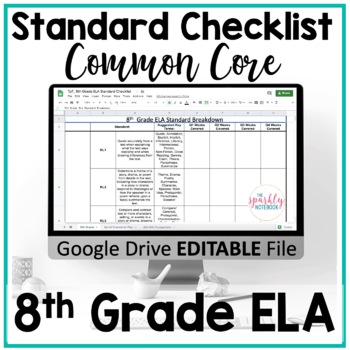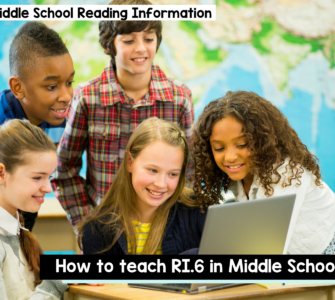A breakdown for teachers who teach W.7 in middle school ELA. In this post, we’ve included learning targets, concept breakdowns, resource suggestions, and activity and assessment ideas!
Using short research projects with students works really well in the middle school schedule when you’re dealing with ‘short classes’ (40-50 minutes), which is perfect since they may just end up being your primary form of writing assessment and practice in your middle school ELA class.
These short research projects are the basis of the W.7 standard in middle school, so they are something we need to embrace and create processes for in our classroom.
Since the W.7 standard literally asks for these projects, we have to make sure that we are getting at least a few of them each year, maybe as often as one per quarter.
The nice thing about the standard is that it does not dictate what the projects have to be about, which opens up the door for a lot of fun topics and themes.
Take that creativity and flexibility where you can get it!
In this post, we are going to talk about how to teach W.7 in middle school ELA and what lessons, resources, and activities you can do to help your students master this standard.
Let’s start with the learning targets!

Learning Targets
By focusing on learning targets, we can model our lessons to hit on very specific goals and skills. In this post, we talk about how we break down each standard and make a plan for learning, practicing, and reviewing the standards throughout the year using the checklists below.



When starting to deconstruct a standard, start with the learning targets. To get the learning targets, break down the standard into 3-5 parts or key skills.
Here are the learning targets on which we developed our resources for W.7.
Teaching W.7.7 (7th Grade)

7th Grade Standard: Conduct short research projects to answer a question, drawing on several sources and generating additional related, focused questions for further research and investigation.
7th Grade Learning Targets
- I can conduct a short research project to answer a question.
- I can use several sources to answer a question.
- I can compose focused questions for additional research and investigation.
Teaching W.8.7 (8th Grade)

8th Grade Standard: Conduct short research projects to answer a question, drawing on several sources and generating additional related, focused questions that allow for multiple avenues of exploration.
8th Grade Learning Targets
- I can draw on several sources when conducting short research projects to answer questions.
- I can generate additional related, focused questions that allow for multiple avenues of exploration.
The Importance of Research
With its magnificent growth, the Internet has made the process of academic research so much easier. It has leveled the playing field for people of all ages to research relevant information and use it to challenge the systems and processes of today.
As helpful as it is that children and teens have more access to the online world, it can be very challenging nowadays because of the OVERLOAD of information that is out there. It is no longer just about finding information for a research paper; it is about sifting through all the information out there and checking for its validity and reliability.
It is important to constantly examine the information placed before us. It is so easy to be led astray by illegitimate websites or fake news.
When conducting research, be careful. Teach students to use their common sense.
Here are a few key tips to repeat to students regularly.
- If you are questioning what you are reading, that is a red flag to dig deeper!
- Go beyond the quick Google search and conduct high-level research so that you can truly learn about the world, and be confident that your research is valid as you share your findings with those around you.
- Validate all information by cross-checking references and sources.
- Pay attention to people’s credentials.
- Stay away from personal opinions.
Resources for teaching W.7
We have a couple of resources available to help you teach W.7 in your middle school classroom. Although these resources are broken down by each grade level, they can both be valuable to you no matter which middle level grade you teach.
The resources above include a lesson/activity for each specific learning target or concept and also include assessments, posters, and answer keys.
Activities and Projects for Practicing and Assessing W.7 in Middle School
- Unpacking the Prompt: Whenever students receive a prompt, they’ll need to unpack it (or break it down) to discover what is actually being asked and what they’re actually supposed to be writing about. Teaching students the process for unpacking the prompt can save them a lot of heartache when posed with prompts on state testing, college-level entrance exams, or even during debates and arguments. We go through the process of unpacking prompts in our 7th-grade resource.
- Quantitative vs. Qualitative Research: Knowing the different kinds of research and the value of both can help students as they search for sources to use in their shorter research writing projects. We go over both forms of research in both the 7th and 8th-grade resources.
- Mini-Research Project (with Partners): Working with partners is a great way to stair-step students into these shorter research projects. In our 7th-grade resource, we’ve provided all the handouts and prompts you’ll need to work through a partner-based mini-research project with your middle school students.
- Expanding Research: Many students have very pedestrian research skills because they can just ask Siri or Alexa their questions. I mean, they don’t even have to type in the question anymore, let alone use a book or sort through several pieces of information covering the same topic. This means that students have no idea what it means to expand on their research. Spend some time deliberately teaching students to write questions that will help them expand on their projects and research and take them outside the scope of the initial project. In our 8th grade resource, we go through this process as part of our W.7 unit.
We understand that teaching writing and the writing process feels like a huge challenge. That is why we create standards-focused resources that provide teachers with activities, lessons, and assessments that explicitly teach each of the middle school ELA standards.
We try to provide updated resources and unit plans to include new forms of technology and research, and we hope the ideas have inspired you in this post!
 How to teach RI.4 in Middle School
How to teach RI.4 in Middle School  Try out these four EASY back-to-school activities
Try out these four EASY back-to-school activities How to teach RI.6 in Middle School
How to teach RI.6 in Middle School 